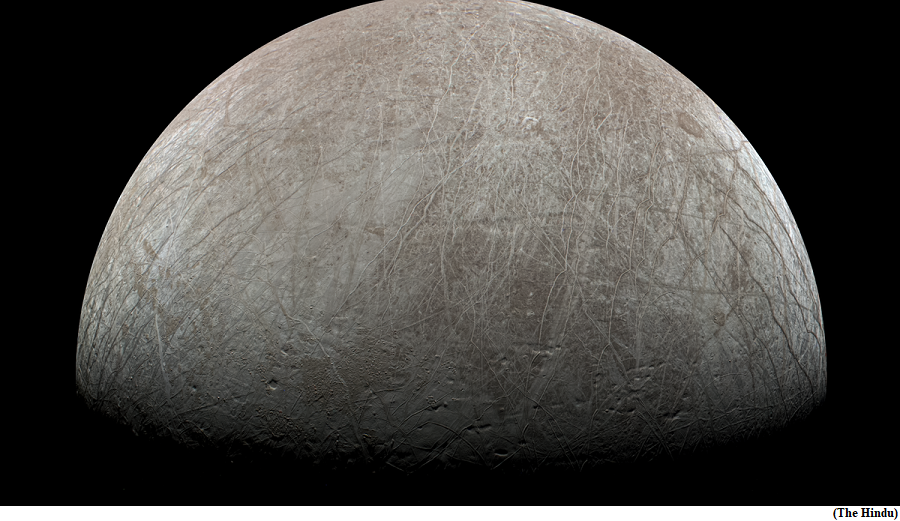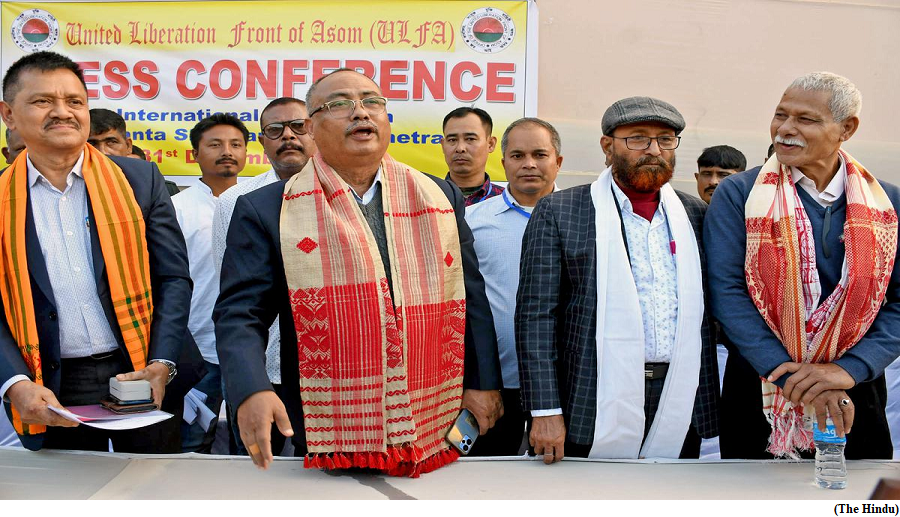From the moon to Europa, six space missions to be excited for in 2024 (GS Paper 3, Science and Technology)

Why in news?
- The year 2023 proved to be an important one for space missions, with NASA’s OSIRIS-REx mission returning a sample from an asteroid and India’s Chandrayaan-3 mission exploring the lunar South Pole region, and 2024 is shaping up to be another exciting year for space exploration.
- Several new missions under NASA’s Artemis plan and Commercial Lunar Payload Services initiative will target the moon.
- The latter half of the year will feature several exciting launches, with the launch of the Martian Moons eXploration mission in September, Europa Clipper and Hera in October and Artemis II and VIPER to the moon in November.
Europa Clipper:
- NASA will launch Europa Clipper, which will explore one of Jupiter’s largest moons, Europa.
- Europa is slightly smaller than the earth’s moon, with a surface made of ice. Beneath its icy shell, Europa likely harbours a saltwater ocean, which scientists expect contains over twice as much water as all the oceans here on Earth combined.
- With Europa Clipper, scientists want to investigate whether Europa’s ocean could be a suitable habitat for extraterrestrial life.
- The mission plans to do this by flying past Europa nearly 50 times to study the moon’s icy shell, its surface’s geology and its subsurface ocean. The mission will also look for active geysers spewing out from Europa.
- This mission will change the game for scientists hoping to understand ocean worlds like Europa.
- The launch window opens October 10, 2024, and lasts 21 days. The spacecraft will launch on a SpaceX Falcon Heavy rocket and arrive at the Jupiter system in 2030.
Artemis II launch:
- The Artemis programme, named after Apollo’s twin sister in Greek mythology, is NASA’s plan to go back to the moon.
- It will send humans to the moon for the first time since 1972, including the first woman and the first person of color.
- Artemis also includes plans for a longer-term, sustained presence in space that will prepare NASA for eventually sending people even farther to Mars.
- Artemis II is the first crewed step in this plan, with four astronauts planned to be on board during the 10-day mission.
- The mission builds upon Artemis I, which sent an uncrewed capsule into orbit around the moon in late 2022.
- Artemis II will put the astronauts into orbit around the Moon before returning them home. It is currently planned for launch as early as November 2024. But there is a chance it will get pushed back to 2025, depending on whether all the necessary gear, such as spacesuits and oxygen equipment, is ready.
VIPER:
- VIPER, which stands for Volatiles Investigating Polar Exploration Rover, is a robot the size of a golf cart that NASA will use to explore the moon’s South Pole in late 2024.
- Originally scheduled for launch in 2023, NASA pushed the mission back to complete more tests on the lander system, which Astrobotic, a private company, developed as part of the Commercial Lunar Payload Services program.
- This robotic mission is designed to search for volatiles, which are molecules that easily vaporize, like water and carbon dioxide, at lunar temperatures. These materials could provide resources for future human exploration on the moon.
- The VIPER robot will rely on batteries, heat pipes and radiators throughout its 100-day mission, as it navigates everything from the extreme heat of lunar daylight when temperatures can reach 224 degrees Fahrenheit (107 degrees Celsius) to the moon’s frigid shadowed regions that can reach a mind-boggling -240 C.
- VIPER’s launch and delivery to the lunar surface is scheduled for November 2024.
Lunar Trailblazer:
- NASA has recently invested in a class of small, low-cost planetary missions called SIMPLEx, which stands for Small, Innovative Missions for PLanetary Exploration. These missions save costs by tagging along on other launches as what is called a rideshare, or secondary payload.
- One example is the Lunar Trailblazer. Like VIPER, Lunar Trailblazer will look for water on the moon.
- But while VIPER will land on the moon’s surface, studying a specific area near the South Pole in detail, Lunar Trailblazer will orbit the moon, measuring the temperature of the surface and mapping out the locations of water molecules across the globe.
- Currently, Lunar Trailblazer is on track to be ready by early 2024.
- However, because it is a secondary payload, Lunar Trailblazer’s launch timing depends on the primary payload’s launch readiness.
PRIME-1 mission:
- The PRIME-1 mission, scheduled for a mid-2024 launch, is Lunar Trailblazer’s ride.
- PRIME-1 will drill into the moon, it’s a test run for the kind of drill that VIPER will use.
- An earlier Commercial Lunar Payload Services mission with the same landing partner was pushed back to February 2024 at the earliest, and further delays could push back PRIME-1 and Lunar Trailblazer.
JAXA’s Martian Moon eXploration:
- The JAXA MMX mission concept to study Phobos and Deimos, Mars’ moons.
- The Japanese Aerospace Exploration Agency, or JAXA, has a robotic mission in development called the Martian Moon eXploration, or MMX, planned for launch around September 2024.
- The mission’s main science objective is to determine the origin of Mars’ moons. Scientists aren’t sure whether Phobos and Deimos are former asteroids that Mars captured into orbit with its gravity or if they formed out of debris that was already in orbit around Mars.
- The spacecraft will spend three years around Mars conducting science operations to observe Phobos and Deimos. MMX will also land on Phobos’ surface and collect a sample before returning to Earth.
ESA’s Hera mission
- It is a mission by the European Space Agency to return to the Didymos-Dimorphos asteroid system that NASA’s DART mission visited in 2022.
- But DART didn’t just visit these asteroids, it collided with one of them to test a planetary defence technique called “kinetic impact.”
- DART hit Dimorphos with such force that it actually changed its orbit.
- The kinetic impact technique smashes something into an object in order to alter its path. This could prove useful if humanity ever finds a potentially hazardous object on a collision course with Earth and needs to redirect it.
- Hera will launch in October 2024, making its way in late 2026 to Didymos and Dimorphos, where it will study the physical properties of the asteroids.
Understanding the peace pact with ULFA
(GS Paper 3, Internal Security)
Why in news?
- The pro-talks faction of the United Liberation Front of Asom (ULFA) signed a tripartite peace deal with the Centre and the Assam government on December 29, 2023.
- The memorandum of settlement has several clauses for accelerating the State’s development and safeguarding the land and political rights of indigenous communities but a worry remains in the form of the anti-talks faction headed by Paresh Baruah.

How was the ULFA formed?
- The ULFA is a by-product of the anti-foreigners Assam Agitation that began in 1979 and ended with the signing of the Assam Accord in August 1985.
- The fear that the Assamese and other indigenous communities would be pushed out of their own backyard by “illegal immigrants” (people from Bangladesh) one day had triggered the agitation.
- While social organisations and students’ bodies chose the path of agitation, a group of radicals, including Arabinda Rajkhowa, Anup Chetia, and Paresh Baruah formed the ULFA on April 7, 1979, to launch an armed struggle with the objective of establishing a sovereign Assam.
- The group took a decade to recruit and train its members in Myanmar, China, and Pakistan before striking with a series of abductions and executions.
- The government responded in 1990 with an offensive codenamed Operation Bajrang and banned the ULFA. Assam was declared a disturbed area with the imposition of the Armed Forces (Special Powers) Act.
When did the peace process start?
- Counter-insurgency operations led to the arrest of 1,221 ULFA members in the early 1990s. With support from terror groups such as Harkat-ul-Jihad-e-Islami and Pakistan’s Inter-Services Intelligence, the ULFA hardliners set up camps in Bangladesh and Bhutan.
- A military offensive by Bhutan in 2003 and the Sheikh Hasina-led Awami League’s return to power in Bangladesh in 2009 saw most of the ULFA members being flushed out from these countries.
- In 2005, the ULFA raised hopes of peace when it formed an 11-member People’s Consultative Group only to backtrack and unleash a fresh phase of terror.
- After falling in the net of the security forces in India in 2009, the leaders of the Rajkhowa-led faction signed a ceasefire agreement with the Centre in September 2011. Opposed to talks, Baruah “expelled” Rajkhowa from the ULFA in 2012.
- In April 2013, the anti-talks group was renamed ULFA (Independent). The pro-talks group signed the peace accord 12 years after the agreement to suspend subversive operations.
What does the peace accord offer?
- The ULFA has agreed to renounce violence, disarm, disband the armed organisation, vacate their occupied camps, and participate in peaceful democratic process established by the law.
- Marking a shift toward non-violence, it aims to ensure the integrity of the country contrary to what the ULFA had initially demanded.
- The Ministry of Home Affairs will make a time-bound programme to fulfil the demands of the outfit and a committee would be formed for its monitoring.
Key Highlights:
- The pact underlines a comprehensive package entailing an investment of ₹1.5 lakh crore for the all-round development of Assam. The most significant part of the accord is the commitment to address the political demands of the ULFA.
- These include maintaining the territorial integrity of Assam through amicable settlement of boundary disputes with neighbouring States in the Northeast and continuation of the “guidelines and methodology” adopted for the delimitation exercise conducted in 2023 in future delimitation processes.
- The pact envisages ensuring maximum representation for indigenous communities in the 126-member Assam Assembly by keeping non-original inhabitants, primarily migrant Muslims, out.
- The 2023 delimitation is said to have made it impossible for non-indigenous communities to contest 106 of these seats.
- Apart from the legislative safeguard, the pact seeks exemption for Assam from Section 3 of the Citizenship Act of 1955 dealing with people who have renounced Indian citizenship or whose citizenship has been terminated, to conditionally stop people of one constituency from being registered in another, and prepare an error-free National Register of Citizens, whose updated complete draft had put 19.06 lakh people out of 3.3 crore applicants on the rejection list.
What are the challenges ahead?
- After the signing of the accord, Chief Minister said 90% of extremism in the State was over. Conflict specialists say the pact, provided the government shows its intent to implement the clauses, was a step in the right direction but lasting peace would be elusive unless Baruah and some 200 fighters of his ULFA (I) group talk truce.
- The ULFA (I) operates from hideouts in the Sagaing Division of Myanmar. Baruah, believed to be based on the Myanmar-China border, has repeatedly said talks with the “Indian occupational forces” would be meaningless without discussing the sovereignty of Assam.



